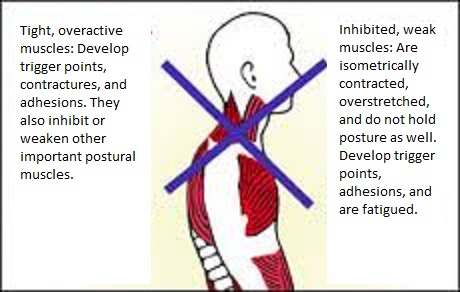What comes to your mind when you think of massage? Fancy white robes with slippers, incense, and candles? Most promoters of massage focus on the relaxation side of massage and while relaxation is a noble goal this neglects most of the very important benefits of massage such as pain relief and normalizing soft tissue dysfunction.
Massage therapy is gaining acceptance more and more as being effective in healing soft tissue disorders.
What exactly is massage and what can it do? Massage is the use of the hands to affect the health of the soft tissues. If you look up neck and low back pain on Web MD you will find that most neck and low back pain is considered to have soft tissue problems and not structural problems as once was thought.
There are many soft tissue problems that can create a whole slew of very confusing and scary symptoms. These are the most common soft tissue problems and how massage can help.
Those Dang Muscle Knots
Muscle knots, or trigger points are considered the most common soft tissue problem and are the most under diagnosed. Many people claim that trigger points are just made up by massage therapists and chiropractors but this is not true. One of the first people credited with studying trigger points was a medical doctor named Janet Travell. Many doctors do recognize trigger points as a pain problem.
Trigger points are an area of the muscle that has a lack of blood and the muscle forms a knot. Trigger points can cause a general ache, stiffness, and pain. Symptoms from trigger points can be as varied as numbness or tingling in limbs, headaches, and weakness. Many conditions such as carpal tunnel syndrome, sciatica, sacroiliac dysfunction, and many others may be misdiagnosed and be caused by trigger points. To make matters worse when these conditions do exist trigger points often are present and treating them is also equally important.
Trigger points are very difficult to diagnose because their symptoms mimic so many other serious problems and there is no definitive test to confirm a trigger point. Usually trigger points are confirmed by touching fibers of the muscle and locating taut bands of tissue. Usually when someone has an exam from a Doctor and there is no clear diagnosis trigger points may be considered. Massage can help trigger points mainly by helping increase circulation to the muscle and trigger point.
Muscle Strain
It’s funny to me when people say “oh thank God, it’s only a muscle!” If you’ve ever had a muscle strain you know it can be quite painful and limiting. And if the muscle strain does not heal fully and completely it can cause problems down the road.
A muscle strain is a tear of the muscle fibers and happens when the muscle is stretched beyond it’s capacity too fast. This may happen with whiplash, bending down to pick something up, playing a sport like soccer and overextending to reach the soccer ball.
When a muscle or muscle group tears it cannot do its work well. The muscles around the strain will spasm to protect the injured area so that it cannot move so that it is not injured further and to let it heal. In that way muscle spasms are a good thing.
Unfortunately sometimes the body has a way of over doing things. And if the area does not have adequate time to completely heal inflammatory agents will stay in the area laying down scar tissue and the spasm and compensation pattern lock into the nervous system as a normal pattern.
Knowledgeable and skillfully applied massage therapy can help with healing of strains. Understanding the healing process and knowing when and what techniques to apply at the different stages of healing can greatly speed and enhance the healing of muscle strains.
Patterns That lock Into the Nervous System

A common compensation pattern known as the Upper Crossed Syndrome. Many compensation patterns can happen but this is very common and sometimes also occurs with the Lower Crossed Syndrome which involves the pelvis
When an area is injured the body naturally compensates to protect the area. If this occurs for a prolonged period of time these compensation patterns lock in your brain and this affects the joints and muscles around the joints. Muscles on one side may be short and tight and lay down adhesions while muscles on the other side maybe weakened, overstretched, tight and also laying down adhesions.
The joints are affected by being in sub optimal positions and are compressed in one area while being overstretched in another. This overexcites joint receptors and signals pain. The joints will be in positions where they will not move smoothly over their cartilage and lose movement. If this continues over time there can be degenerative changes to the joint. These patterns affect the optimal movement of the body and develops strain patterns.
When it comes to chronic and recurring pain it is really important to understand the role of the nervous system and pain patterns. The longer a pain pattern persists the more difficult it becomes to treat because the brain will always go back to the pattern that has been there the longest.
Other treatments like movement re-education are also extremely helpful because they help to re-establish new movement patterns in the brain but without addressing the soft tissue problems that also develop these will be much harder to correct because you’re working against tissues that have changed their structure and shape. Massage therapy can help heal and break these patterns by decreasing and mobilizing adhesions and scar tissue, increasing range of motion in the joints, and decreasing trigger point activity.

